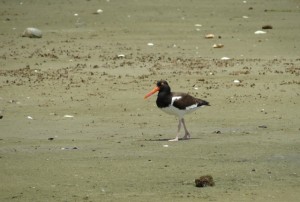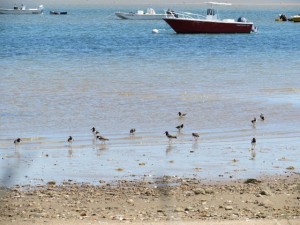On Tuesday June 7, 2013 coastal waterbird colleague Tom Faughnan and I encountered the largest group—or parcel—of American Oystercatchers we’ve ever witnessed. (A group of these birds is known as a parcel—as in a ‘murder’ of crows, which also is rarely used!)
Part of our job is to look for American Oystercatchers that have bands on their legs to assist an Atlantic coast study aimed at reversing declining oystercatcher populations. These bands have colors that correspond with the state they were banded in and a 2 digit combination of either letters or numbers that represent the individual. For example, American oystercatchers banded in Massachusetts are yellow with black letters or numbers.
When we arrived at one of our sites near Tern Island in Chatham we could not see the flats but were greeted by the wonderfully playful calls of several American Oystercatchers. I said to Tom, “Sounds like a large flock!” but I don’t think that either of us was anticipating its actual size.
Peaking over the crest of the small dune, we observed 17 oystercatchers which is a much larger number than the usual 3 to 5 that we normally see. Our managers speculate these may have been birds that didn’t find mates this season or lost nests to predation.
We sprinted back to the truck to grab our cameras and raced back to get some photos. Then the challenge of reading the bands was upon us. As we were reading band combinations, two more birds came in. This pattern continued until the group had reached a flock size of 27! Tom mentioned that it was like we were on their wintering grounds in Florida where flock sizes can be in the hundreds.
As the tide rose we watched the birds fly off in small groups until almost all had left and relocated at the end of Scatteree Road (also known as Minister’s Point), which is an excellent location for viewing these birds at a lower tide. It was an amazing experience in which we were able to get 13 band combinations including one bird that had red band which means it was banded in Georgia!
If you are interested in looking for oystercatchers and their bands, be sure to bring a spotting scope! These birds don’t let you get very close. For more information about reporting banded oystercatchers, how to read their bands and for some general information on the research into this fantastic bird, visit http://amoywg.org/. If you’d like to see more of my bird photos, click here.
Thanks,
Keenan Yakola
Wellfleet Bay Coastal Waterbird Program



